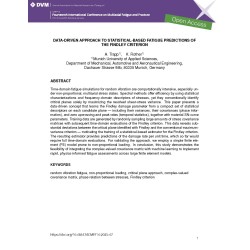- Nur online erhältlich



<<Open Access>>
Random vibration loading, particularly under non-stationary conditions, poses significant challenges for fatigue assessments of complex structures. These challenges stem from three key aspects along the analysis process, spanning the input, system, and output stages: the complex nature of in-service vibration loading, often comprising superimposed random, harmonic, and shock components derived from long-term operational measurements (input); the vast scale of finite element (FE) models, featuring numerous degrees of freedom and multiple potential critical cross-sections (system); and the resulting non-proportional multiaxial stress states, which are both challenging and computationally demanding to evaluate (output).
Addressing these challenges…

Datenschutzbedingungen (bearbeiten im Modul "Kundenvorteile")

Lieferbedingungen (bearbeiten im Modul "Kundenvorteile")

Rücksendebedingungen (bearbeiten im Modul "Kundenvorteile")
Random vibration loading, particularly under non-stationary conditions, poses significant challenges for fatigue assessments of complex structures. These challenges stem from three key aspects along the analysis process, spanning the input, system, and output stages: the complex nature of in-service vibration loading, often comprising superimposed random, harmonic, and shock components derived from long-term operational measurements (input); the vast scale of finite element (FE) models, featuring numerous degrees of freedom and multiple potential critical cross-sections (system); and the resulting non-proportional multiaxial stress states, which are both challenging and computationally demanding to evaluate (output).
Addressing these challenges requires methodologies capable of efficiently managing large datasets and FE models while accurately evaluating non-proportional multiaxial stress states. A statistical-based fatigue assessment offers a powerful solution by replacing the evaluation of extensive time-series with the statistical characterization of loading and stress states. This includes statistical characterizations such as spectral densities and covariance analysis. Building on previous work, where critical planes were identified within seconds across entire FE models using a modal approach together with kurtosis metrics, this study extends the approach to incorporate damage-based criteria.
In this study, we adopt a data-driven approach by evaluating time-varying stress tensors via conventional time-domain damage parameters and relating them to their statistical characterization. We compare the accuracy of this statistical-based estimation against the time-consuming traditional time-domain evaluation by assessing the deviations in the identified orientations and damage predictions.
On this basis, we derive a strategy to use the statistical-based approach as a pre-processing step to identify the most damaging nodes and orientations in complex FE models. This extension enhances the efficiency of critical plane identification and fatigue life predictions under complex random vibration loading, particularly by better accounting for interactions between normal and shear stresses than previous approaches.